A majority of 2025 model year half-ton trucks no longer even offer a V8 engine. It’s almost unimaginable – but that doesn’t make it less true.
The Chevy Silverado is one that offers two.
It is also still available in regular cab (two door) configuration – and with an eight foot bed. Several rivals – including the Ram 1500 and Nissan Titan and Toyota Tundra – come only in crew and quad configurations and (in the case of the Ram) with nothing longer than a six foot bed.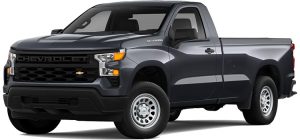
The Chevy also can be had with a diesel engine, which several rivals – including its chief rival, the Ford F150 as well as the Ram 1500, the Toyota Tundra and the Nissan Titan – do not offer.
Of course, there are some catches. There are always catches. Let’s get into some of those now.
What It is
The Silverado 1500 is Chevy’s half-ton pickup. It is available in three different cab configurations – Regular (two door), Double (four doors, with smaller rear doors) and Crew (four full-size doors) and with three different-length beds – 5.8 feet, 6.5 feet and 8 feet.
It is also available with a turbocharged 2.7 liter four cylinder engine (it is the only half-ton truck that is available with a four cylinder engine) as well as either of two V8 engines (5.3 liters or 6.2 liters) and a turbodiesel (3.0 liters) engine. It is only one of two half-ton truck currently on the market that offers this many engine options – and this variety of options.
The other one being the Silverado’s main rival – the Ford F-150.
Prices for the 2025 Silverado start at $37,000 for the base Work truck with a regular cab, the 5.8 foot bed, the four cylinder engine and 2WD. Four wheel drive bumps the price up to $41,600.
You can opt for the long bed as a $200 upgrade.
The Double Cab’s pricing hierarchy begins at $40,300 for the Work Truck trim, with the same drivetrain as the regular cab Work truck. From there, you can select from Custom ($43,600 to start), LT ($48,100), LT Fleet ($50,200) and RST ($52,400 trims). 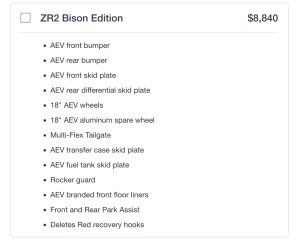
The Crew Cab starts at $42,700 for the Work Truck trim – once again, equipped with the same drivetrain and features as the Regular and Double Cab versions.
This version of the Silverado is also available in a number of additional trims that are not offered with the Regular or the Double Cab, including the Custom Trail Boss ($51,800), High Country ($62,700) and the ZR2 ($70,000) which comes with a plethora of off-road upgrades, including 33 inch all-terrain tires, tow hooks, locking front and rear differentials, a full-size spare, upgraded underbody skid plates; off-road capability can be ante’d up by adding the optional Bison package ($8,840) which includes off-road suspension tuning and greater articulation clearance for the tires and front-end angle of approach, among other things.
What’s New For 2025
The Trail Boss trim now comes standard the previously optional all-terrain tires and the ten speed automatic that was previously standard with most of the Silverado’s available engines is now only available with 4WD-equipped models.
2WD versions now come standard with an eight speed automatic.
What’s Good
Plethora of cab/bed/drivetrain options.
13,300 lb. maximum towing capacity (more than Ram, just a couple of hundred pounds shy of class-best Ford F-150).
Work Truck version is relatively affordable and comes standard with features such as AC, power window and locks and cruise control that most people consider essential.
What’s Not So Good
Most trims come standard with the four cylinder engine – and to get either V8 engine, you must buy one of the more expensive trims.
Like all current half-ton pick-ups, the Silverado is so big it just barely fits in the typical supermarket parking lot spot.
Like all current half-tons, it’s expensive. Even the base Work trim with just 4WD added stickers for just shy of $42k. Remember when a base-trim truck cost less than a typical mid-sized car?
The Silverado’s engine lineup is unlike the lineup offered by any other half-ton truck besides the F-150, both in terms of type as well as variety.
The standard engine is a 2.7 liter four cylinder engine. It is the smallest engine (and the only four cylinder engine) available in a current model year half-ton truck. It’s turbocharged – to make up for its small size – and makes 310 horsepower and 430 ft.-lbs,. of torque. That makes it stronger than most V8s that were available in half-ton trucks back in the day.
Gas mileage is 18 city, 21 highway for the 2WD version and 17 city, 20 highway for the 4WD version. And you can pull about 9,000 lbs. with this four cylinder-powered pick-up.
There are two available V8 engines – in the higher trims. Both are overhead valve designs – meaning they have just one camshaft in the block rather than at least two (and commonly four) cams on top of the cylinder heads. The pushrod layout is more compact, which leaves more room to work under the hood – and there are fewer parts inside the engine and so fewer potential failure points.
The first of the two V8s displaces 5.3 liters and makes 355 horsepower 383 ft.-lbs. of torque (note that this is less torque than made by the 2.7 liter four). The second – the biggest – displaces 6.2 liters and makes 420 horsepower and 460 ft.-lbs. of torque. Back in the day, only Ferraris and a few high-end, high-performance cars offered that kind of power.
Now it’s available in a pick-up truck.
Depending on the configuration – i.e., 2WD/4WD and bed length, etc. – you can tow up to 13,300 lbs.
There’s one more engine to consider.
There’s an available 3.0 liter turbodiesel that makes 305 horsepower and 495 ft.-lbs.of torque – the most torque you can get in a Silverado half-ton. The diesel’s chief benefit isn’t to reduce your fuel costs – a Silverado so equipped rates 20 city, 23 highway or about the same as the 2.7 liter four – but to allow a Silverado to tow a heavy trailer a long distance with fewer stops along the way for fuel vs. the V8s.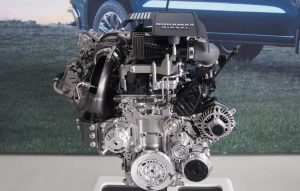
Equipped with the diesel, a Silverado has a highway driving range of about 550 miles on 24 gallons of fuel.
All of the Silverado’s available engines are paired with either an eight speed automatic or a ten speed automatic. 2WD models come with the eight speed transmission; 4WD models get the ten speed transmission, which has tighter gear spacing and more overdrive gears. This gives a slight fuel economy advantage, which helps offset the fuel economy disadvantage of the weight added by the 4WD system.
Unlike the new Ram and Tundra, the Chevy is not saddled with “partial hybrid” tech or an elaborate 48 volt electrical system. The only battery you’ll ever have to replace is the 12V battery that starts the engine.
On The Road
There is a reason why half-ton trucks have become the best-selling vehicles on the market – and it’s not because they’re useful, although that helps. It s because they are wonderfully comfortable and useful.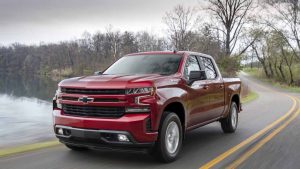
Current half-tons are bought by people who – 40 years ago – would have bought a full-size American sedan or station wagon. Like today’s half-tons, these were comfortable and useful – because they were big and powerful. They were body-on-frame, which gave them the structural strength to tow (and carry) a heavy load – and they were available with big V8s and had plenty of room for a family of five or even six. Plus room for two or three bodies wrapped in carpet in the trunk.
All they lacked was 4WD and a bed.
Today’s half-tons have both – and none of today’s passenger cars have either. Very few even offer V8s anymore – even the high-end models. And even the biggest of them are small relative to the size they used to be. None of them are comfortable for a family of five or even six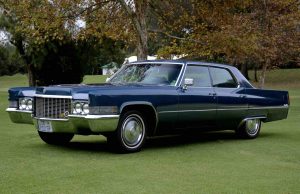
The Silverado and its rivals are.
But the Chevy one-ups most of its rivals by offering two V8s, which you can’t get in the new Ram 1500 or the Tundra. The turbo-sixes in the latter have their merits, but they lack the comforting and authoritative bass rumble that only a V8 can authentically deliver (the word is italicized to reflect the electronically conjured V8 sound that emanates from the audio system of the V6 Tundra). When you push the start button or floor the accelerator – the sounds you hear remind you of what’s absent in the others.
But it’s really big.
Of course, that is part of the attraction. But it’s also something of a Catch 22 in that many parking lots and even roads aren’t sized to accommodate. This is the dilemma of driving any current half-ton truck. It is analogous to being at the wheel of an ocean liner. Once out of the harbor and in the open water, you’re king of the world, like Jack at the bow of Titanic.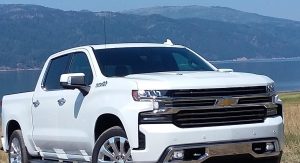
But when you’re trying to angle into a parking spot at Wal Mart, it can be a challenge to line up straight without some maneuvering. And then backing out (and straightening her out) in order to be able to get out, when it’s time to leave. On country roads with just one lane in each direction and those lanes the width of most current cars, a truck this size will use most of the lane, leaving little margin on either side. Which means if another Titanic happens to be steaming at you from the opposite direction, there’s less margin for error if either of you wander a little.
That said, you’ll get the appeal if you drive this rig. From the commanding position to the wealth of space and the surplus of power it’s like 1972 all over again and you’re at the helm of a mighty dreadnought such as they used to make ’em – only much nicer and far more capable.
At The Curb
As already mentioned, this is a big truck. How big? More finely – how long?
Well, the base regular cab Work Truck with the standard short (five foot) bed is 210.9 inches long. A High Country Crew Cab with a six foot bed is 241.4 inches long. To put this length in some perspective, one of the biggest – longest – cars you can buy is a BMW 7 Series sedan and it is a mere 212.2 inches long. The High Country Chevy is a couple of feet longer than that.
These trucks – not just the Chevy – are also tall. Again, that is part of the appeal. But it also means being higher-up than things like the little kiosks at drive-thru banks and that can mean having to reach down to reach the little vacuum tube thing you use to send your paperwork to the teller inside. And it means you’ll be exercising your sense of spatial relationships to avoid scraping the sides of your truck on the pillars to either side.
Then there is the height – of the bed walls. Sound the trumpets!
Combine this with the height of the truck relative to the ground and it can be a challenge to reach into the bed if you are standing on the ground. Even if you stand more than six feet tall.
Luckily, there are nooks built into the rear bumper to help you step up. But it’s astounding how much higher all current half-tons are vs. the half-tons of the past. You used to be able to look down into the bed if you were standing beside it. Now you have to look up – and over – the bed walls.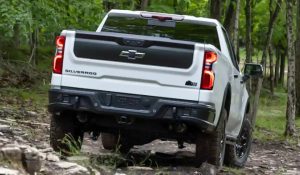
On the upside – so to speak – the Chevy’s high bedwalls serve the same function as having what they used to call a state kit added to the lower bed walls of trucks back in the day, when the owner needed to corral the cargo he was carrying. You can load more mulch and such without spillover. This Chevy is also available with a multi-section tailgate that allows for the upper section to be folded down or the whole thing. This allows you to – as a for-instance – carry rebar that’s longer than the eight-foot bed without the tailgate entirely down and the load secured in the carve-out made by lowering the upper section only.
There’s another way this truck isn’t like they used to make ’em.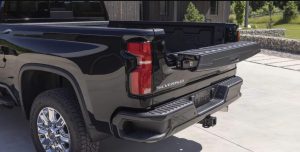
Even the base trim Work truck comes standard with AC, power windows and locks, cruise control, heated outside mirrors and a stereo. Back when half-ton trucks were the size of today’s mid-sized trucks – which was as recently as the ’90s – a truck with those amenities would have been considered loaded rather than “base.”
The higher trims are more loaded than any dreadnought luxury sedan of the ’90s, too – and also current ones. The LT (and higher) trims have dual LCD instrument and secondary arrays and you can get luxury-level gadgets such as a Heads Up Display, heated rear seats and even a self-driving feature – Super Cruise – in the High Country trim.
The Rest
It’s not just the V8s – plural.
Other half-tons, such as the Nissan Titan, have come standard with them. The Tundra used to offer one, as did the Ram. It’s that this Chevy is one of just two current half-tons that offers more than just a six – and what used to be the Big Three configurations: Regular cab, extended can and crew cab.
Along with three different bed lengths.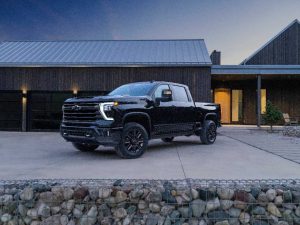
The Ford F-150 is the only rival in the class that still does, too. And the F-150 has an advantage over this Chevy in that you can get the V8 in the lower trims Even the base XL trim. If you want either of the Silverado’s two V8s, you must buy one of the more expensive trims first.
And that gets expensive.
The Bottom Line
America-style size, power and capability are still available. Just in a different form.
. . .
If you like what you’ve found here please consider supporting EPautos.
We depend on you to keep the wheels turning!
Our donate button is here.
If you prefer not to use PayPal, our mailing address is:
EPautos
721 Hummingbird Lane SE
Copper Hill, VA 24079
PS: Get an EPautos magnet or sticker or coaster in return for a $20 or more one-time donation or a $10 or more monthly recurring donation. (Please be sure to tell us you want a magnet or sticker or coaster – and also, provide an address, so we know where to mail the thing!)
If you like items like the Baaaaaa! baseball cap pictured below, you can find that and more at the EPautos store!



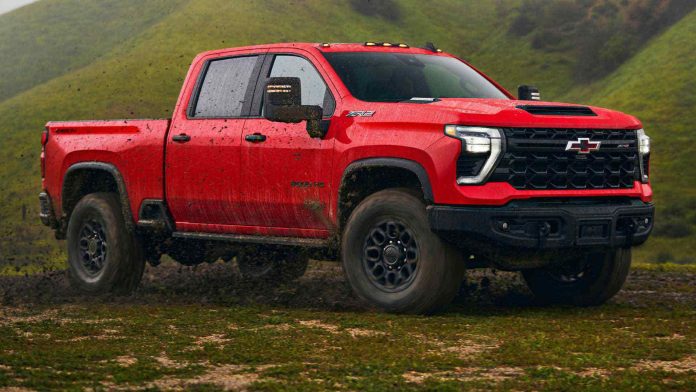


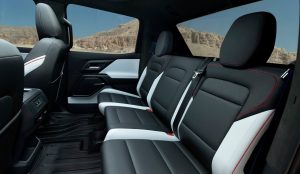







My last GM truck was 2014, after 10 of them. I couldn’t take their horrible short shifting programming to save a mpg anymore. I went to the dark side with 2 Ram 5.7’s and have been in love ever since. But ohhh how things change. The new Hurricane I6TT might have enough turbo lag to piss me off. I’ll have to drive both the SO and HO and see. If they are unacceptable, back to GM I go with their 6.2. I’ve been told by reputable owners that the shifting problems are gone with the 10sp, and they have at least caught up to Ram’s exceptional ride with their ‘adaptive shocks’. We’ll see.
But GM still messes with ya bad, and these adaptive shocks are only avail. on the highest trim, while w/Ram, you could get the good stuff mid-trim and up.
The engine responsiveness and ride quality will win the day (2 trucks again over a year or so)
I factory ordered my ’01 Silverado RC/SB/2WD/5.3/4L60 and it stickered for $24,341 (LS trim), which translates to over $43k in today’s FedBux.
Back then, you could get a basic W/T version for around $20k.
Mine weighs about 4200lbs (dry), easily fits in the garage/parking spaces, can tow 8000lbs and gets 17-21mpg (which even exceeds the EPA estimate of 15/19.)
Nearly 25 years later with all the added size, price, tech/complexity, and fuel economy that barely changed, none of this sounds like progress – especially since these GMT800 trucks can easily run 250k-400k miles.
Time will tell if these current GM trucks will prove to be that durable.
I wonder if they add a boosted v8 for the Denali trim now that Ram offers 540hp
Diesel would be nice but local dealers have them for $63,000. Too damn much.
Will these trucks sell???? Remains to be seen, I suppose…but these folks can paraphrase….
“The Rent is too damn high!!!” – Preacher Man…
“It’s the economy, stupid”-some politician somewhere…
I see fields of unsold vehicles everywhere I look these days….
YMMV….
I like the bodies wrapped in carpet. I think a lot of people don’t think about that when buying a truck—and it’s really pretty important. You just never know when you may need to pack’em in.
I see all kinds of trucks when I’m out and about but the Tacoma has got to be the most popular. All different years, old old ones, lots of new ones. They are everywhere—likes flies or mosquitoes. Don’t know how many of them are brand new. Wouldn’t think anyone would want a brand new Tacoma or Tundra from the reviews I’ve seen you write Eric. Just doesn’t make sense doing that to a truck—-making it trans. What was Toyota thinking?
I agree with other people on here. If the car manufacturers and other manufacturers had stood up to the EPA and said no—we ain’t/can’t/won’t do that, the EPA would’ve backed down. After all, this EPA stuff is just regulations, not laws—-correct?
Tacoma bottom line:
Min $500 to $1500 over BB asking price. Theres a basic 5 spd 04 tacoma w 60k on our CL. $17k no budge.
Imagine how many spare parts are available for these.
My new hire in 2002 showed up his second Monday morning in a brand new Chevy truck with biggest engine and all bells and whistles. $38k.
No matter whats under the hood or stuffed behind the wheels, society wont go back to when we gave the kid shit for blowin’ all his cash a week into his new job. . .
It’s amazing how much physically larger trucks are now (and for no good reason). I park my 24-year-old Sierra next to anything modern, and it’s just tiny in comparison. Yet rated more-or-less the same on payload/towing.
The one nice thing new trucks have that I’d like to have is an integrated brake controller. But the plug n play aftermarket controller works just fine.
also not sure if you meant to say Whats new ‘Ford’ twentyfive
Thanks, Norman – fixed!
‘Like all current half-ton pick-ups, the Silverado is so big it just barely fits in the typical supermarket parking lot spot.’ — eric
About three years ago, a buddy of mine bought one of these honking great silver Silverados for one purpose: to shuttle a fifth-wheel trailer back and forth to their winter destination. Otherwise, it remains parked in the yard, unused and unloved. It has less than 10,000 miles on it, and he’s really to sell it now after arranging for off-season storage of the fifth wheel. Goodbye, rude beast!
Errata: 1. Gas mileage for the 4WD version should be 17 city, 19 highway [not 29]? 2. ‘state kit’ –> stake kit.
Thanks, Jim – for catching the typo. Just fixed. Should be 20 MPG (not 29) for the 4WD.